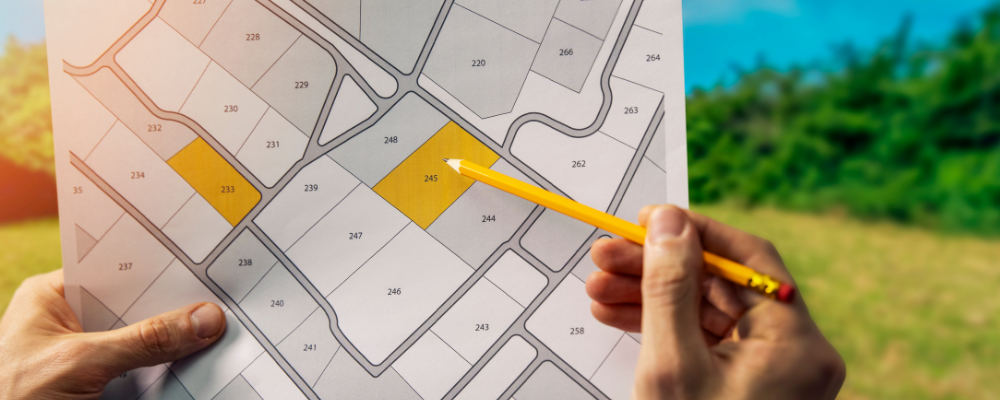The Short Summary
Flipping land is a real estate investing avenue that offers investors some major benefits. These include less competition, high returns on investment, and a quick turnaround time. All in all, land investing can be a very attractive option.
However, as with most things, there are also risks to be aware of when it comes to land investing. These include construction risks, zoning laws and regulations, and finding the right buyers. Mitigating these risks means being aware of them and planning for them ahead of time.
Jump To
Is Land Flipping A Viable Business Model In 2025?
Land flipping refers to the process of purchasing vacant or raw land, or the contract for land, in order to flip it as an investment after turning it into a valuable asset. For example, contractors or home builders can help investors transform land into an attractive asset. There are also other avenues for flipping land, where a property doesn’t need to be built.
Land flipping can still be a viable business model in 2025, however success in this realm is based on several factors. The viability of a land flipping business hinges on factors like local market trends, location, and each individual’s investment strategy. Each area has its own unique market trends which can increase or decrease the demand for land, and along with this, zoning regulations and developments play a role in these trends.

How To Flip Vacant Land Without Building A Property
There are ways to flip land without having to build a property on the land. We’ll outline a few of these methods, for those who don’t intend on developing the land and would prefer to flip it vacant. The choice of method should depend on your investment goals, the characteristics of the land, local market conditions, and your available resources.
Parcel Flipping
This method is used by investors who do not wish to develop the land, but instead the investor contracts to purchase vacant land, markets it effectively and then sells the land to another investor for a profit. This strategy is focused on acquiring individual parcels and does not require extensive development.
Step 1: Identify promising areas for purchasing land at a reasonable price through extensive research into local real estate markets. These areas would have a growing demand for land or other factors that make land desirable.
Step 2: Buy a parcel of land that will allow you to make a reasonable profit.
Step 3: Conduct due diligence on the property to make sure that there are no liens against it, and that the title is clear.
Step 4: Market the land by highlighting the best features, and how it could be used more effectively in the future. You can market the land via online platforms, real estate agents and other marketing channels.
Step 5: Sell the land to a potential buyer. Once an offer has been made, make sure to negotiate the terms of the sale, and when you’ve come to an agreement, proceed with the sale by completing the closing process. This is the time when you can subtract all acquisition and selling costs from the final selling price to receive your profit.
Residential Lot Flipping
Unlike parcel flipping, residential lot flipping deals with land that is already zoned for development or subdivided. Residential lot flipping involves:
Step 1: Finding an empty lot that has great potential for residential development and is already zoned or subdivided is a good way to get started.
Step 2: Purchase the land using your own capital or simply purchase the contract for the land. A land contract allows you to provide an investor with the right to purchase the land.
Step 3: Sell the land or the contract to another investor who will develop the land. Usually this would be a development investor, or builder.

Land Banking
Land banking, on the other hand, is a long-term strategy that involves keeping the raw land until the market is right for selling, and then making a better profit.
Step 1: Locate the right piece of land by doing extensive research into each area and looking for areas with high future development potential. Consider factors like population growth, infrastructure projects, and economic trends.
Step 2: Acquire a piece of land in an area where you anticipate appreciation in market value over the future.
Step 3: Hold onto the land while you monitor the market conditions in the area and the development in the surrounding area.
Step 4: Once the surrounding area experiences growth and demand increases, it’s time to sell the property and cash in on the profit that you’ve been waiting for.
Value Added Improvements
Value added improvements, such as subdivision or land development approvals, allow investors to purchase raw land and sell it without having to build, but rather using other methods to make the raw land more attractive to investors or developers.
Step 1: Locate the right piece of land in an area where getting approvals, subdividing or adding value in other ways would create a more desirable deal for investors to purchase and increase the market value of land.
Step 2: Purchase the land and make sure to understand all the local zoning regulations and subdivision requirements, along with any other regulations that you would need to comply with.
Step 3: Obtain all necessary approvals and permits for the subdivision, development or other improvements you intend to make on the land. This may involve rezoning, environmental assessments, and other regulatory steps.
Step 4: Develop the planned infrastructure that will be needed for the project, whether that’s subdivision or other improvements. This doesn’t require building a property, but it may require installing utilities, for example.
Step 5: Market the land to potential buyers who fit the profile. For example, subdivisions may appeal to different types of buyers more than basic landscaping.
Step 6: Negotiate and close the sale, once you’ve found a buyer who is willing to pay the amount you need to make a profit.
How To Buy Vacant Land, Develop A Property And Then Flip It
Flipping land after developing a property can be a profitable exercise, but it requires careful planning and execution. Real estate investors who choose to do a land flipping project that involves development will have extra steps to take, let’s take a closer look at these.

Step 1: Get To Know The Market
The first step towards successfully flipping land is to conduct extensive market research into the area where you are going to buy land. To get started, research the local market trends, property values, and the demand for properties. You’ll need to select an area that has a strong demand for the type of property you intend to develop. Consider factors like neighborhood amenities, school districts, and proximity to essential services.
Step 2: Find Financing
The next step is to acquire financing to help you purchase the land and develop it. This may involve a combination of personal funds, loans, and partnerships with investors or lenders. Choose the best lender and financing option for your investment goals and development plans.
Step 3: Choose The Right Land
Once you’ve found the right area, you can get to work on finding the land for sale that best suits your investment goals. Once you’ve found land for sale that is a good option, negotiate the purchase of the land at a price that allows for a reasonable profit margin.
Step 4: Conduct Due Diligence
This step is often missed or not performed adequately. In order to get ahead of any issues, do your due diligence on the property to make sure that there are no legal issues that could come up, liens or otherwise, that the title is clear and that the land is suitable for your intended purpose.
Step 5: Create A Development Plan
This is one of the most crucial steps when flipping land. A comprehensive development plan for the land is imperative to the success of the project. This should include architectural and engineering designs, permitting requirements, and a construction timeline. The plan should include be used to keep the project on track, in terms of both time and money.
Step 6: Obtain Permits
Work with the local authorities to obtain the necessary permits for all the development that you plan on doing. This may involve zoning changes, building permits, and environmental assessments. These permits will ensure that the work you do is permitted by law, and there can be no issues later in the project.
Step 7: Begin Construction
Begin the construction process following the approved plans and designs. Hire qualified contractors and manage the project closely to ensure it stays on schedule and within budget. Make sure that the development of the land adds value by adding features that appeal to buyers.
Step 8: Market The Property
Start marketing the property before development is complete, so that once the project is finished, you are already in negotiations with buyers, or you’ve found a buyer. You can use various marketing channels, such as real estate listings, social media, and real estate agents.
When buyers express interest, make sure to get a favorable price so that you can make a good profit on the deal. It’s also important to be aware of market timing, selling the developed land at the right time is crucial to get the profit that you’re aiming for.
Step 9: Close The Sale
Complete all the relevant paperwork and legal requirements to sell the property, transfer the title to the buyer and calculate your profit. You can calculate your profit by subtracting all costs associated with land acquisition, development, and sale, from the sale price. Be sure to include financing costs, construction expenses, and any other related costs.
Benefits of Flipping Land
Real estate investors who choose to invest in buying and selling land can be very successful. Sometimes more so than other real estate investing strategies. Here’s why…

High ROI
A land flipping business can provide investors with high returns, which means that investors can potentially make much more on land flipping projects than other types of real estate investment. Provided that the market conditions and the deal itself are right.
Less Competition
Competition can be stiff when it comes to investment strategies like flipping houses and rental properties. However, land flipping offers investors a whole lot less competition. Add to this the fact that there is plenty of land to go around, and this makes the strategy even more attractive.
Quick Turnaround Time
Depending on the strategy you use, land flipping doesn’t need to require any building or development. This means that the process is quicker than flipping projects where building or renovating is required, and profits can be earned faster.
Lower Upfront Investment
In comparison to traditional property development, purchasing only the land and then flipping it, requires less money upfront. This makes land flipping accessible to a wider range of investors.
Flexibility
Land flipping offers investors a choice of multiple strategies that involve holding onto the land, a quick flip and other options. Investors can employ the best strategy for the local real estate market, and their investment goals. This makes them more adaptable to changing market conditions.
Quick Exit Strategy
For real estate investors who need a quick exit strategy, land can be sold quickly to liquidate the asset and provide a fast way to access funds.
Reduced Holding Costs
Vacant land typically incurs fewer ongoing costs, such as property taxes and maintenance, compared to developed properties. This can improve cash flow and result in a more profitable overall investment.
Lower Risk
For land flipping projects where construction is not being done, investors can avoid the risks that come with construction projects. These include cost overruns, construction delays, and structural issues. This means that the investment process is simpler, quicker and less costly.
Risks of Land Flipping
While flipping land looks like a very attractive real estate investing strategy, it comes with a few risks to be aware of. Take note of the following risks so that you can mitigate these.

Zoning and Regulations
Local zoning laws and regulations can change, affecting the land’s potential uses. Failure to stay informed about these changes can lead to unanticipated hurdles, so this is a major risk to bear in mind.
Development Costs
If you decide to use a strategy that includes developing the land, this adds a whole new world of costs to the equation. Development also comes with risks such as overspending and delays.
Timing
Timing is crucial when flipping land. Selling too soon or too late can affect your profitability, and being unable to sell a property in a downturn can lead to losses. It’s important to keep abreast of rapidly changing market conditions, so that you can time your sale right.
Harder To Find Buyers
While finding land deals may not be that difficult, finding buyers takes time. Some investors who flip land can take 6 months to find buyers. This can leave investors without earning any profits for a significant period of time, which can impact cash flow.
Environmental Issues
Any unforeseen environmental challenges, such as contamination, can be costly to address and may affect the land’s marketability. So, it’s vital to do due diligence on the land before purchasing it, and make sure that it has been inspected thoroughly for any potential environmental problems.
Permits
Obtaining the necessary permits for development or changes in land use can be a lengthy and complicated process. Delays in permitting can impact your timeline and budget, which can be risky for the overall investment.
Final Tips For Completing A Profitable Land Flip
Flipping land after developing a property can be a lucrative venture, but it involves a combination of real estate expertise, financial planning, and effective project management. It’s crucial to have a well-thought-out strategy and stay flexible to adapt to changing market conditions. Land investing, like many other strategies, involves buying and selling at the rights times, and taking into account market value and other important factors.
Frequently Asked Questions
Single-family homes have long been the go-to for real estate investors. This preference is largely due to familiarity; many investors have lived in or grown up in these types of homes, making them a comfortable choice. Here are some advantages:
- Immediate Demand: There’s generally a constant demand for housing, ensuring a steady pool of potential buyers or renters.
- Tangible Improvements: Renovations and upgrades can quickly increase a home’s market value.
- Predictable Cash Flow: Renting out a single-family home can provide consistent monthly income.
However, investing in single-family homes can be capital-intensive and time-consuming, requiring ongoing maintenance and management.
Investing in Land
On the other hand, investing in land offers a different set of opportunities and challenges:
- Appreciation Potential: Land tends to appreciate over time, especially in areas with growing populations or development prospects.
- Lower Entry Costs: Generally, land is less expensive to purchase than developed properties, leading to lower initial investments.
- No Maintenance Costs: Unlike homes, land doesn’t require repairs or upkeep.
But, investing in land also carries certain risks, such as market fluctuations driven by zoning laws or changes in urban planning. Additionally, generating income from land often requires creativity, like leasing it for agricultural purposes or future development.
Making the Choice
Your investment decision will depend on several factors, including risk tolerance, available capital, and long-term financial goals. Whether you choose land or single-family homes, both have unique benefits and potential drawbacks that should be carefully considered.
Investing in land through tax defaulted auctions offers an intriguing opportunity to acquire property at significantly reduced prices. These auctions typically begin with bids set at the amount of the delinquent property taxes, enabling buyers to snatch up land for pennies on the dollar.
Strategies for Buying Land At Tax Defaulted Auctions
Residential Lot Flips: One straightforward method is purchasing vacant residential lots at discounts ranging from 60% to 80%. These discounted properties can then be resold to nearby residents, often resulting in quick and profitable transactions. The value perceived by neighboring buyers can lead to attractive returns on investment.
Leverage Owner Financing: Another effective strategy involves catering to buyers with limited access to traditional financing. By offering owner financing, sellers can tap into a market of credit-challenged buyers, creating a win-win scenario. Buyers benefit from manageable installment plans, while sellers enjoy a steady income stream from interest payments.
In summary, buying land at tax defaulted auctions not only provides a pathway to acquire property below market value but also opens the door to diverse and lucrative income opportunities. Whether through strategic flips or financing arrangements, the potential for profit is substantial and sustainable.




